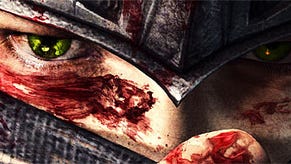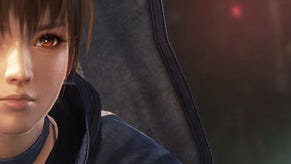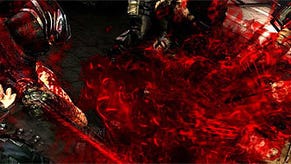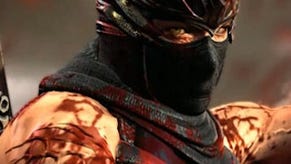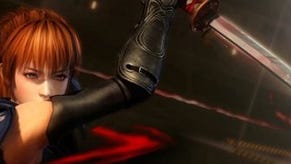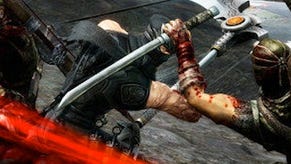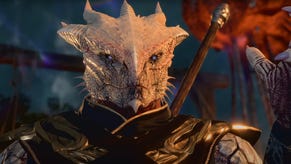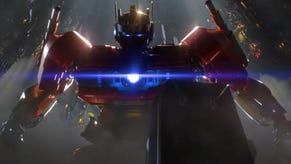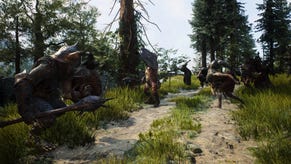Ninja Gaiden 3 Razor's Edge: Nintendo grows up
Ninja Gaiden 3: Razor's Edge isn't a simple port; It's proof that Nintendo wants in on on the mature market. VG247's Dave Cook takes the final code for a spin and gets his hands dirty.
Around about Autumn 2007 I became confused by a rather vocal minority of gamers. It was the same group who found it necessary to lash out at Nintendo for daring to sew up the family and pre-teen market with Wii. It was as if - to defend their elite status in gaming - they had to publicly savage the company online. For what? Being a smart business and making a lot of money in difficult times? Nintendo, clearly, were fools.
I didn't understand it. After all, here was this rich, largely-untapped audience that Nintendo had identified and chose to - rather wisely - pursue. PS3 and Xbox 360 certainly weren't speaking to families the way they are today, but you can bet that they all want a little slice of Nintendo's money pie now. See: Kinect, Move and Wonderbook.
“The idea that ‘real’ gamers only play mature games is outmoded because after all, we were all children once, we’ve all played colourful kid’s games before. Or do you only become a ‘real’ gamer once you become old enough to play mature games?”
So what if Nintendo was going after a new, captive audience? Wii still had Mario, Zelda and all its classic franchises, and besides Nintendo was never a bastion of violence or mature content to begin with - see the severely watered-down edition of the original Mortal Kombat on SNES for one (thanks to clubberbboy for the clip). The knee-jerk reaction had me absolutely stumped at the time.
Then came the Wii U announcement at E3 2011, and with it all of the usual family-bashing and people asking about its multi-format potential. Except this time, the console's launch window was brimming with mature titles, games like Assassin's Creed 3, Mass Effect 3, Call of Duty: Black Ops 2 and Ninja Gaiden 3: Razor's Edge.
Suddenly, claims that Nintendo's remit has been to purely chase the elderly, family or child-friendly markets became largely base-less, spun out as a form of derogatory criticism from armchair pundits who view violence as a form of validation for their hobby.
The idea that 'real' gamers only play mature games is outmoded because after all, we were all children once, we've all played colourful kid's games before. Or do you only become a 'real' gamer once you become old enough to play mature games? What are the rules? I'm still massively confused here.
None of us are exempt from what Nintendo is trying to achieve, because after all, we may all have kids of our own one day, and we may also want to introduce them to the gaming hobby via suitable titles. Well, you're not seriously going to let them play Mortal Kombat or Battlefield 3 under-age are you? Jesus I sincerely hope not.
Walking on the razor's edge.
I recently had three hours of game time with the finished code of Ninja Gaiden 3: Razor's Edge on Wii U. It's violent, massively violent. In fact, it's more violent that the PS3 and Xbox 360 editions, with tons of extra executions, the addition of dismemberments, multiple weapons and the removal of poorly-received features.
It's not just a port either, as Team Ninja has changed some areas, tweaked attacked patterns, re-tooled bosses and added in new survival rounds, not to mention adding two stages featuring Dead or Alive's Ayane, and free Kasumi DLC coming after launch. Overall, it's a good effort at improving on the original game, even if that core game still falls behind genre-mates DmC: Devil May Cry, Metal Gear Rising: Revengeance or Bayonetta.
But what is surprising is that - during any given encounter - areas can become littered with body parts and blood in a matter of seconds, with arms flailing through the air, heads popping like ripe melons and chest cavities bursting open faster than you can blink.
And the game's being published and marketed by Nintendo.
Yeah, as it happens Nintendo wants this game on Wii U 100%, and is giving Team Ninja its full support in bringing it to the masses. What does that say about the company now? Well, now that is has conquered the 'casual' market - for want of a better term - Nintendo can now focus on converting the 'real' gamers - for want of a better term - to its cause.
Will the move work? Who knows? But make no mistake, this is a seriously violent game on a format often laughed at for pandering to babies. So I thought I'd give my initial impressions on the first three hours that I played, and to discuss the new changes and violent content at hand.
Push it to the limit.
One of the most significant changes between Razor's Edge and its predecessor is the return of multiple weapons. Call me crazy, but I thought the idea to only give Ryu variations on his sword - rather than a full set of diverse weapons - was a real step back following the multi-weapon combat of Ninja Gaiden 2.
But Team Ninja has fully restored all of Ninja Gaiden 2's weapons in this release, letting you tear through enemies with dual katanas, a giant scythe, long-ranged spear and a set of claws that attach to Ryu's ankles and wrists. The variety is welcome, although you can't change between weapons on the fly like you can in DmC or Bayonetta.
You have to either tap the Wii U GamePad menu to select a different weapon, or use the Pro Controller's d-pad - both of which pauses the game while you do so. This means the potential for improvised, multi-weapon combos isn't there, and leaves the attack combos feeling shallow by comparison.
“The accentuated, wanton slaughter of faceless enemies, while looking rather badass in the process speaks to a lot of people. It’s empowerment at a raw level, and it comes with a shiny 18+ PEGI rating to boot.”
It's still fun though, playing more like a 3D riff on classic games like Final Fight or Streets of Rage. It favours simple commands, instead of focusing on the deep combo trees of other hack-n-slash titles, and although that may not speak to veterans of the genre, the game is still very difficult in parts.
I say 'in parts' because one or two boss encounters I attempted on normal mode were rather simple. One battle against a giant T-Rex boiled down to simply dodging left and right using the left trigger until it bopped its head on a wall and fell over, leaving it open to attack. It felt far easier than previous Ninja Gaiden titles, but still, challenging spikes do occur.
Another change between Ninja Gaiden 2 and its successor were dismemberments. In the second game Ryu could lop off his enemy's limbs, leaving them hopping or crawling around in a vain attempt at a final, health-sapping suicide attack. But Ninja Gaiden 3 saw that mechanic removed entirely.
It has also been restored in Razor's Edge and while it looks daft and plays into the tongue -in-cheek style of the Team Ninja's world, the threat of suicide attacks makes you consider your approach more often. Getting too close to a desperate, half-dead foe can result in death if they manage to get hold of you.
Plus, this is the kind of violent stuff 'real' gamers go for isn't it? The accentuated, wanton slaughter of faceless enemies, while looking rather badass in the process speaks to a lot of people. It's empowerment at a raw level, and it comes with a shiny 18+ PEGI rating to boot. In picking up the Ninja Gaiden license, it suggests Nintendo are listening to the concerns of its critics.
Like a bat out of hell.
The game's opening level takes place in London, and it sees Ryu Hayabusa tooling around the cobbled streets battering thugs with his sharp instruments, unleashing charged attacks and occasionally dishing out Ninpo attacks to deal splash damage and regain health for every hit landed.
While fighting, the Wii U GamePad displays Ryu's attack command list. It's a neat touch, but don't go expecting any highly technical moves here, as Team Ninja has delivered a streamlined combat system indeed. Ranged kunai and explosive arrow attacks can be also be used to create space, but do little to broaden combat.
Another neat difference between the games orignal release and Razor's Edge are the removal of annoying 'Gears of War' moments, in which Ryu would be locked into a slow walk, while listening to comm chatter in his ear. They've been completely removed.
“If you yearn for blistering combos and incredible feats of skills across multiple button presses then you will find fault with Razor’s Edge at many junctures. It’s just not as deep or as slick, which is funny considering the original Ninja Gaiden reboot on Xbox was – at one point – deemed a leader in its field.”
Transitions between scenes now take the form of combat arenas that Ryu is sucked into whenever his cursed arm takes hold of him. These areas are simple survival games that end either when Ryu is defeated, or when the scene times out, hurling a barrage of foes at you.
These hubs can be used to hone skills and earn extra combat points to be spent in the upgrade store, which is where players can learn new techniques or expand Ryu's weapon set. Conscious attempts have been made to really flesh out the Ninja Gaiden 3 template, and while welcome, still result in a game that feels behind the rest of the genre.
But again, I have to keep stressing that its still fun - in the same relatively mindless way as corridor beat-em-ups of old. Personally, the Streets of Rage series is my all-time favourite - because I'm weird like that - so if you liked those kind of simplistic beat-em-ups, then there's much to enjoy here.
If you yearn for blistering combos and incredible feats of skills across multiple button presses then you will find fault with Razor's Edge at many junctures. It's just not as deep or as slick, which is funny considering the original Ninja Gaiden reboot on Xbox was - at one point - deemed a leader in its field.
So it's shallow, and some people will enjoy that, but what Razor's Edge really succeeds at is showing that Wii U can still play home to violent titles, and that Nintendo is all for it. Whether or not the trend will continue remains to be seen, but don't forget that Bayonetta 2 - a game that neither Sony or Microsoft wanted on their respective formats - is coming exclusively to Wii U. That's an exciting prospect if you're a fan of this genre like me.
So, there are the many pros and many cons of Ninja Gaiden 3: Razor's Edge. It's a mixed bag for sure, but it is most certainly a significant improvement over the original in almost every regard - from control and frame rate, to visuals and aesthetics.
But enough from me, let us know what you make of Nintendo's approach of publishing the game, and the 'casual/hardcore' divide that hangs over Nintendo these days.
Ninja Gaiden 3: Razor's Edge hits Wii U across Europe from January 11th.
Disclosure:
In writing this article, Nintendo loaned Dave a locked debug Wii U console with Ninja Gaiden 3 installed to play the game, and he returned it straight after his session. No merch or advertising was offered or accepted alongside this coverage.






